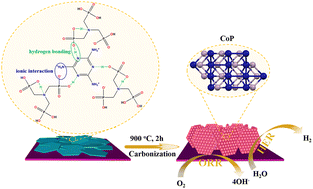Regulating the coordination capacity of ATMP using melamine: facile synthesis of cobalt phosphides as bifunctional electrocatalysts for the ORR and HER†
Abstract
Due to the complexity of the synthetic process of cobalt phosphides (CoP), ongoing efforts concentrate on simplifying the preparation process of CoP. In this work, amino tris(methylene phosphonic acid) (ATMP, L1) and melamine (MA, L2) are assembled into two-dimensional (2D) organic nanostructures by hydrogen bonding and ionic interactions via a supramolecular assembly, which greatly weakens the coordination ability of L1 with Co2+. As the introduced L2 is rich in carbon and nitrogen, it allows the cobalt–organophosphate complex to be placed under a strongly reducing atmosphere during the high-temperature calcination process to achieve an in situ phosphating purpose. The resulting catalyst (N-CoP/NC) exhibits the sought-after enhanced oxygen reduction reaction (ORR) and hydrogen evolution reaction (HER) performance. For the ORR in 0.1 M KOH, an enhanced onset potential (0.908 V vs. RHE) and diffusion limiting current (6.280 mA cm−2) can be obtained, which is comparable to those of 20% Pt/C (0.911 V vs. RHE, 5.380 mA cm−2). For the HER in 0.5 M H2SO4, an overpotential of 150 mV is required to drive a current of 10 mA cm−2. Moreover, Density Functional Theory (DFT) calculations reveal the catalytic pathway of N-CoP/NC.



 Please wait while we load your content...
Please wait while we load your content...